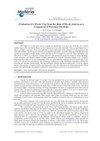Control of a mechanism for the application of variable axial loads in a multiaxial fatigue testing machine
IF 1.2
4区 材料科学
Q4 MATERIALS SCIENCE, MULTIDISCIPLINARY
引用次数: 0
Abstract
The loads acting on mechanical components are usually complex, and the more traditional fatigue analysis criteria may be non-conservative, especially in out-of-phase and non-proportional loadings. Many multiaxial fatigue models have been developed and need to be experimentally validated. This work describes the load control mechanism of a low-cost electromechanical multiaxial fatigue testing machine, which applies variable axial and torsional loads. A load cell interconnected to the motor control system was manufactured and instrumented with extensometers. For the axial load, a four-bar mechanism coupled to a power screw was designed to apply alternating axial loads, thus ensuring a higher load frequency and preservation of the motor, which will not need to alternate its direction of rotation. The machine’s control system, focused on out-phase loading, is based on the data sent by the load cell and pulse encoders per degree for each motor, ensuring good accuracy in applied loads. Tests were carried out to check the system’s response, in which it was possible to apply load curves of torque and axial force in different phase shift angle. Therefore, several existing multiaxial fatigue models can be tested with good reliability.多轴疲劳试验机中用于施加可变轴向载荷的机构的控制
作用在机械部件上的载荷通常是复杂的,传统的疲劳分析准则可能是非保守的,特别是在非相位和非比例载荷下。目前已经建立了许多多轴疲劳模型,但需要进行实验验证。本文描述了一种低成本的机电多轴疲劳试验机的载荷控制机理,该试验机可承受可变轴向和扭转载荷。制造了一个与电机控制系统相连的称重传感器,并使用伸长计进行测量。对于轴向负载,设计了一个与动力螺杆耦合的四杆机构来施加交变轴向负载,从而确保更高的负载频率并保留电机,而不需要改变其旋转方向。机器的控制系统,专注于外相加载,是基于每个电机每度的称重传感器和脉冲编码器发送的数据,确保了应用负载的良好精度。通过试验验证了系统的响应特性,在不同的相移角度下,可以应用扭矩和轴向力的负载曲线。因此,现有的几种多轴疲劳模型可以进行可靠性测试。
本文章由计算机程序翻译,如有差异,请以英文原文为准。
求助全文
约1分钟内获得全文
求助全文
来源期刊

Materia-rio De Janeiro
MATERIALS SCIENCE, MULTIDISCIPLINARY-
CiteScore
1.00
自引率
25.00%
发文量
51
审稿时长
6 weeks
期刊介绍:
All the articles are submitted to a careful peer-reviewing evaluation process by the journal''s Editorial Board. The Editorial Board, reviewers and authors make use of a web based proprietary automated tool to deal with the reviewing procedures.the Revista Matéria''s article reviewing restricted access system - SEER. Authors are not informed about the identity of the reviewers.
 求助内容:
求助内容: 应助结果提醒方式:
应助结果提醒方式:


